I have 3 tables :
Stock - ID, Description, Quantity etc
Equipment - ID, Description
LinkStockEquipment - StockID, EquipmentID, Quantity
There may be multiple types of equipment required for each stock item.
I want to output all the data into a csv file for the customer.
Ideally they want:
StockID, StockDescription, StockQuantity, Equipment1, Equipment1Qty, Equipment2, Equipment2Qty, Equipment3, Equipment3Qty etc
So my starting point is:
SELECT * FROM Stock
LEFT JOIN LinkStockEquipment ON LinkStockEquipment.StockID = Stock.ID
LEFT JOIN Equipment ON Equipment.ID = LinkStockEquipment.EquipmentID
But of course this just gives me multiple rows when there are multiple types of equipment per stock item. I could just take the top or bottom rows using a SORT and a MAX or MIN but how would I then access the remaining rows, one by one to link them in.
Could it be something like (syntax wrong but trying to get message across)
SELECT * FROM Stock
LEFT JOIN LinkStockEquipment AS LSE1 ON LSE1.StockID = Stock.ID LIMIT 1
LEFT JOIN LinkStockEquipment AS LSE2 ON LSE2.StockID = Stock.ID AND LSE1.StockID <> LSE2.StockID LIMIT 1
LEFT JOIN LinkStockEquipment AS LSE3 ON LSE3.StockID = Stock.ID AND LSE1.StockID <> LSE2.StockID AND LSE2.StockID <> LSE3.StockID LIMIT 1
LEFT JOIN Equipment ON Equipment.ID = LinkStockEquipment.EquipmentID
Apologies if this has already been answered directly, I've only used basic SQL before so I have not fully understood the other answers to similar questions.
MySQL Left Join Many to One Row might do what I want but I also need the quantity of each type of equiment so it didn't seem to be the solution.
Update 1: I have also looked at MySQL pivot row into dynamic number of columns however I didn't see how it could apply when I need both equipment and quantity each time, rather than just one item to pivot on. I'll read up more on Pivoting.
Update 2: Reading about pivoting it would give me a separate column for each equipment type but there could be 100 different equipment types. However each stock item might only have 2 or 3 out of those 100 different types. I only therefore want to list what those equipment types are not a column for each.
Given:
Stock ID | Equipment ID | Equipment Qty
---------------------------------------
A1 | E1 | 5
A1 | E2 | 3
A2 | E3 | 4
A2 | E4 | 6
A3 | E5 | 2
I would like
Stock ID | Eqpmnt ID 1 | Eqpmnt Qty 1 | Eqpmnt ID 2 | Eqpmnt Qty 2
------------------------------------------------------------------
A1 | E1 | 5 | E2 | 3
A2 | E3 | 4 | E4 | 6
A3 | E5 | 2 | |
Not
Stock ID | E1 | E2 | E3 | E4 | E5
------------------------------------------------------------------
A1 | 5 | 3 | | |
A2 | | | 4 | 6 |
A3 | | | | | 2
Unless I have misunderstood pivoting?
Update and Result: For some reason I cannot set this as the answer to the question, however in case this helps anyone else ...
Thanks to Juan below, I added an additional row into my LinkStockEquipment table using info from this question : mysql increment value based on previous record
UPDATE t1
SET t1.Counter = t2.Counter
FROM LinkStockEquipment t1
LEFT JOIN
(
SELECT
t.EquipmentID,
t.StockID ,
(SELECT COUNT(*) FROM [LinkStockEquipment] AS x WHERE x.EquipmentID <= t.EquipmentID
AND x.StockID = t.StockID) AS Counter
FROM [LinkStockEquipment] t
) as t2
ON t1.EquipmentID= t2.EquipmentID AND t1.StockID = t2.StockID
So then the table looks like:
Stock ID | Equipment ID | Equipment Qty | Counter
-------------------------------------------------
A1 | E1 | 5 | 1
A1 | E2 | 3 | 2
A2 | E3 | 4 | 1
A2 | E4 | 6 | 2
A3 | E5 | 2 | 1
Now I can pivot, so using
SELECT P.StockID, P.[1], L1.Qty, P.[2], L2.Qty, P.[3], L3.Qty
FROM (SELECT StockID, EquipmentID, Counter
FROM [LinkStockEquipment]) AS D
PIVOT(MAX(EquipmentID) FOR Counter IN([1],[2],[3])) AS P
LEFT JOIN [LinkStockEquipment] L1 ON L1.StockID = P.StockID
AND L1.EquipmentID = P.[1]
LEFT JOIN [LinkStockEquipment] L2 ON L2.StockID = P.StockID
AND L2.EquipmentID = P.[2]
LEFT JOIN [LinkStockEquipment] L3 ON L3.StockID = P.StockID
AND L3.EquipmentID = P.[3]
I can left join in the Stock table details and I have the desired result.


